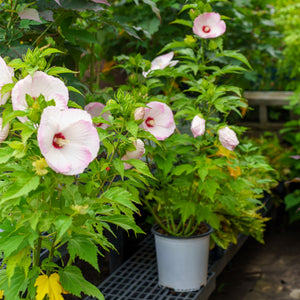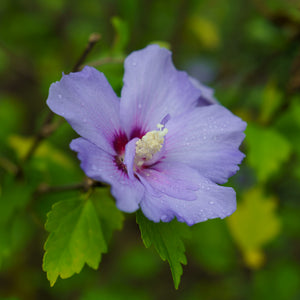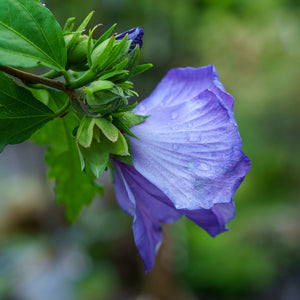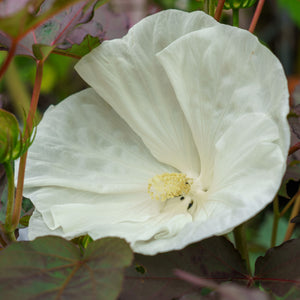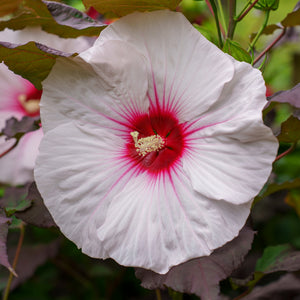The Hibiscus Guide
Hibiscus is a diverse group of flowering plants known for their large, colorful blooms and bold, tropical appeal. In the landscape, hibiscus delivers exceptional summer-to-fall interest with flowers that range from soft pastels to vivid reds, pinks, purples, and whites. With dozens of varieties available—from hardy perennial types to tropical shrubs—hibiscus brings lush, dramatic color and a sense of exuberance to garden beds, borders, containers, and even wetland edges.
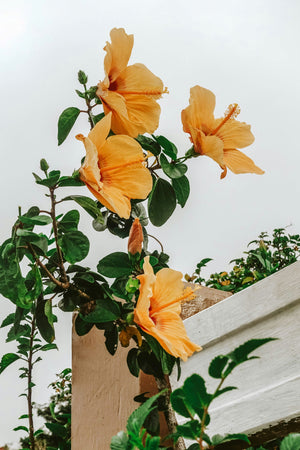
About
The hibiscus family encompasses a wide range of species and hybrids, each with its own characteristics, climate tolerance, and growth habit. In landscape settings, the most common types fall into two primary categories: tropical and hardy.
Tropical hibiscus (Hibiscus × rosa-sinensis) is typically grown as a container or houseplant in temperate zones, thriving outdoors only in Zones 9–11. These plants bloom continuously in warm weather and feature glossy green leaves and flamboyant flowers that can span 4 to 8 inches across.
Hardy hibiscus, including Hibiscus moscheutos and its many hybrids, is a cold-tolerant perennial native to wetlands in the eastern U.S. Cultivars such as ‘Berry Awesome’, ‘Holy Grail’, ‘Starry Starry Night’, and ‘Midnight Marvel’ produce dinner-plate-sized flowers on herbaceous plants that die back each winter and return vigorously in spring. The Luna series (‘Luna Red’, ‘Luna White’, and ‘Luna Rose’) offers compact selections suitable for smaller gardens or containers.
Foliage also varies between cultivars. Some varieties like ‘Mahogany Splendor’ and ‘Dark Mystery’ offer deep burgundy or nearly black foliage, while others like Hibiscus tiliaceus ‘Tricolor’ are grown primarily for their variegated leaves.
Whether you're looking for a striking specimen, a tropical accent, or a pollinator magnet, hibiscus offers unmatched flower power and versatility.
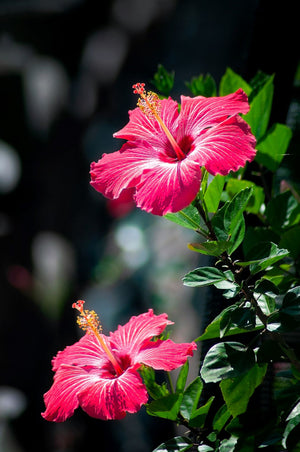
PLANTING
Proper planting sets the foundation for vigorous growth and maximum blooms.
USDA Hardiness Zones:
- Hardy hibiscus (Hibiscus moscheutos and hybrids): Zones 4–9
- Tropical hibiscus (Hibiscus × rosa-sinensis): Zones 9–11 (grown as annuals or container plants in cooler climates)
Soil: Hibiscus prefers rich, well-drained soil high in organic matter. Hardy types tolerate heavy, moist soils, making them suitable for rain gardens or low spots. Tropical hibiscus needs sharp drainage in containers or raised beds.
Sunlight: Full sun (6+ hours) is essential for abundant blooms. Hardy varieties can tolerate light afternoon shade in hot regions but may produce fewer flowers.
Watering: Hibiscus likes consistent moisture, especially while establishing. Hardy varieties can handle wet soils, while tropical types prefer moist but not soggy conditions.
Spacing: Space hardy varieties 3–5 feet apart depending on their mature width. Compact cultivars like ‘Luna Red’ need just 2–3 feet, while larger selections like ‘Vintage Wine’ or ‘Cranberry Crush’ may reach 4–5 feet across.
Planting Time: Plant in spring after frost danger has passed. In cooler climates, wait until soil has warmed before planting hardy types.
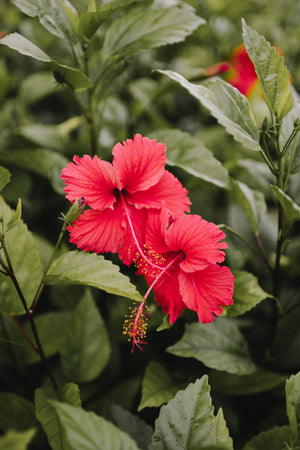
CARE
With a little seasonal attention, hibiscus will reward you with show-stopping flowers for months on end.
Watering: Water deeply and regularly, especially during dry spells and flowering season. Tropical types in containers may require daily watering in hot weather.
Fertilizing: Feed regularly during the growing season. Use a balanced, slow-release fertilizer or a bloom-boosting formula with slightly higher phosphorus content.
Pruning:
- Hardy Hibiscus: Cut back stems to 4–6 inches above ground in late fall or early spring. New growth will emerge from the base each year.
- Tropical Hibiscus: Prune lightly in spring to shape and encourage bushier growth. Deadheading is optional, as flowers drop naturally.
Pests & Diseases: Watch for aphids, Japanese beetles, and spider mites. Neem oil or insecticidal soap can control infestations. Leaf spot and rust may appear in humid conditions but are rarely severe.
Mulching: Apply 2–3 inches of mulch to conserve moisture, protect roots, and suppress weeds. In cold climates, mulch heavily over hardy hibiscus in late fall to insulate the root zone.
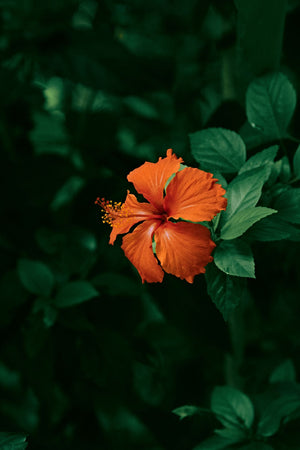
HOW TO USE
Hibiscus is one of the most dramatic and versatile flowering plants in the garden. With selections available for all climates and garden sizes, it can serve as a vibrant focal point or play a supporting role in larger plantings.
Focal Point: Large, colorful blooms make hibiscus a natural focal point in borders, entryways, or mixed beds. Cultivars like ‘Holy Grail’, ‘Midnight Marvel’, and ‘Perfect Storm’ create unforgettable impact when planted singly in prominent garden locations.
Mixed Borders: Use hardy hibiscus in sunny mixed borders with companions like black-eyed Susan, ornamental grasses, butterfly bush, Russian sage, or echinacea. These combinations extend seasonal interest and provide contrast to hibiscus’s bold blooms and lush foliage.
Rain Gardens and Wet Areas: Hardy varieties thrive in damp soils and are perfect for rain gardens, pond edges, or low-lying areas where drainage is an issue. Plant alongside other moisture-loving natives like joe pye weed, swamp milkweed, or cardinal flower.
Pollinator and Wildlife Gardens: Hibiscus flowers attract bees, butterflies, and hummingbirds in abundance. Incorporate into pollinator-friendly plantings with monarda, salvia, and agastache to build a long-blooming, high-impact habitat.
Container Plantings: Tropical types such as Hibiscus × rosa-sinensis are ideal for patio containers. Use as upright thrillers in combination pots, surrounded by trailing plants like sweet potato vine or calibrachoa. Overwinter indoors or treat as annuals in cold climates.
Seasonal Hedges and Screens: Taller, bushier varieties like ‘Lord Baltimore’ and ‘Vintage Wine’ can be used in mass to create seasonal privacy screens or garden dividers that die back in winter but return lush and full in spring.
Color Themes and Specialty Gardens: With a wide color palette available, hibiscus can be coordinated with specific color schemes. Use white varieties like ‘French Vanilla’ and ‘Luna White’ in moon gardens, or deep reds and burgundies for dramatic, bold palettes.
Tropical or Exotic-Themed Gardens: Combine tropical hibiscus with palms, cannas, elephant ears, and banana plants to evoke a lush, resort-style garden—even in temperate regions during summer months.
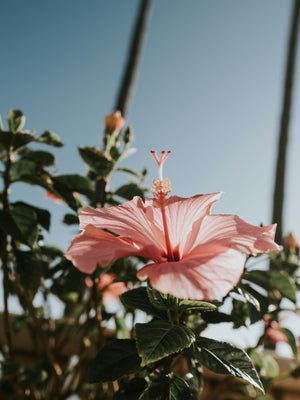
Common Questions
Are hibiscus perennials? Yes—hardy hibiscus (like Hibiscus moscheutos) are true perennials in Zones 4–9. Tropical hibiscus are perennials only in Zones 9–11; elsewhere they must be overwintered indoors or grown as annuals.
How to care for hibiscus? Provide full sun, rich soil, and consistent moisture. Fertilize during the growing season and prune as needed. Hardy types need to be cut back to the ground in late fall or early spring.
How to propagate hibiscus? Hibiscus can be propagated by softwood cuttings in late spring or early summer. Tropical types root easily in water or soil. Hardy types can also be propagated by division or root cuttings.
How to prune hibiscus? Hardy hibiscus should be cut to the ground in late fall or early spring. Tropical types can be pruned lightly in spring to encourage bushy growth and remove leggy or damaged branches.
Do deer eat hibiscus? Deer may nibble on hibiscus foliage and buds, particularly tropical varieties. Hardy hibiscus is less preferred but not deer-proof.
Do rabbits eat hibiscus? Yes, rabbits may feed on tender stems and foliage, especially on young plants. Use fencing or repellents if browsing becomes a problem.
Is hibiscus poisonous to dogs or cats? Some hibiscus species, particularly tropical types, can cause mild gastrointestinal upset if ingested by pets. While not highly toxic, it’s best to prevent pets from chewing on leaves or flowers.
Do hibiscus need full sun? Yes. Full sun (at least 6 hours per day) is essential for prolific blooming and healthy growth. Too much shade will result in fewer flowers and leggy growth.
When do hibiscus bloom? Hardy hibiscus typically blooms from mid-summer to early fall (July to September). Tropical hibiscus can bloom nearly year-round in warm climates or under controlled indoor conditions.
Conclusion
Hibiscus delivers unmatched floral drama, whether grown as a hardy perennial or a tropical accent. With bold blooms, varied foliage, and a broad range of colors and forms, hibiscus suits everything from pollinator gardens to rain gardens, containers, and tropical-themed landscapes. When placed and cared for properly, these long-blooming plants offer months of showstopping beauty and unforgettable presence in the garden.
The Hibiscus Collection
Sold Out
Sold Out

